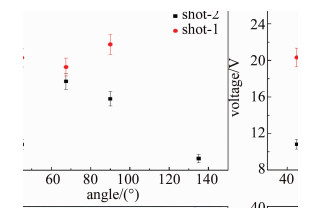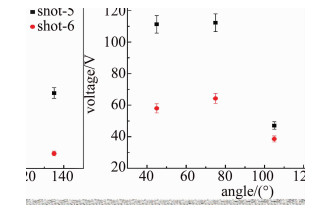HTML
-
惯性约束聚变(inertial confinement fusion,ICF)是一种实现核聚变的有效方法,它依靠惯性约束产生大量等离子体来获得核聚变过程中的超高温超高压条件[1-3]。直接驱动就是通过激光束直接辐照靶丸,加热靶体薄壁。在这一过程中,包裹在靶丸外层低密度冕区中的电子将吸收外界能量,形成超热电子。伴随超热电子的出射,能量被传递到靶壳的高密度区域,并驱动烧蚀,最终实现内爆[4-5]。然而,在这一过程中不断有高强度、宽频率(几十兆赫兹~5GHz)的电磁脉冲(electromagnetic pulse,EMP)被激发[5-7],其主要来源可以归结为高能电子从靶体表面逃逸,并对靶体进行充电。此外,靶杆的中和电流也对EMP的产生起到了一定的作用[8]。因此,电磁脉冲的强度与热电子之间存在密切的关系[9]。
目前的研究表明:由不同的加热过程或吸收过程产生的热电子呈现出不同的角分布。例如对于p偏振光,对非相对论而言,由共振吸收和真空加热产生的超热电子一般沿着密度梯度方向发射,而由相对论场加热和激光尾流场产生的超热电子一般沿着激光的传播方向发射[10]。经过准直的超热电子沿着激光的镜面方向发射[11-12]。CAI等人报道了超短超强激光与固体靶相互作用形成的热电子的角分布,他们发现,当入射激光的角度设置为45°时,激光反射方向和法向方向有两个发射峰[13]。当热电子从靶上逃逸时,从靶杆中产生中和电流,如果将整个结构等效为半偶极子天线,则可以发射高强度EMP信号。并且,如果使用绝缘靶杆,则无法产生较高频范围(GHz)内的EMP信号,信号强度将大幅衰减[14],这是因为通过靶杆的回流电流减少的同时,由此产生的辐射电磁能量也会减少;此外,靶体与靶杆的形状也会明显影响EMP辐射的强度[15]。
在强激光与靶相互作用辐射电磁脉冲的研究方面,电磁脉冲与激光强度[16-17]、靶型的关系[18-20]已经被广泛研究。在本研究中,作者揭示了电磁脉冲强度、分布与激光参量及靶杆之间的关系,这有助于加深对激光与固体靶相互作用产生电磁脉冲机理的理解。
-
本文中进行的所有实验都是在一个总能量为100J的实验装置上进行的。如图 1所示,超短脉冲激光(4ns,波长1053nm)以45°角照射铜箔产生的电磁脉冲采用B-dot天线进行测量。为有效地对比分析,用连接在带宽为8GHz的示波器(Agilent Infiniium DSO80804B/8GHz40gsa/)上的几个超小B-dot(EMP探头)对电磁脉冲进行定点测量。所有天线被放置在距离靶室中心3cm的6个不同方向,分别为45°, 67.5°, 75°, 90°, 105°和135°(所有这些角度都是以激光入射的零度方向作为参考给出的)。为了比较EMP特征,采用的是同一种靶,但支撑靶体的靶杆分别为导电型和绝缘型以观察回流电流对电磁辐射的影响。表 1中给出了打靶的发次编号与激光能量、EMP探头的对应关系。
shot laser energy /J stalk 1 63.9 conductive 2 64.7 insulative 3 50.2 insulative 4 70.7 insulative 5 51.1 conductive 6 40.6 conductive 7 69.0 conductive 8 52.8 insulative 9 54.5 insulative
-
图 2展示了不同位置检测到的EMP信号波形图。第1发激光照射在由导电靶杆支撑的铜箔上,产生的电磁脉冲波形如图 2a所示,其幅值大于由第2发激光打在绝缘靶杆支撑的铜箔上产生的电磁脉冲(如图 2b所示)。第1发激光产生的电磁脉冲信号在90°处达到峰值20V,而第2发在67.5°处达到峰值17V,表明激光辐照两种靶时,在靶杆产生充放电模式有变化,导致了出射热电子的不同分布[7-8]。
图 3中对比了两组不同靶杆在不同位置的电磁脉冲信号。圆圈和方形分别表示来自导电靶杆和绝缘靶杆的信号。可以看出,来自于导电靶杆的信号明显比绝缘靶杆的信号大,最大达到了22V。图 4中正三角形和倒三角形表示的两组数据采集于绝缘靶杆,方形和圆圈表示的两组数据来自导电靶杆。经过仔细对比之后发现,来自导电靶杆的电磁信号明显大于来自绝缘靶杆的信号。
如图 5所示,图 5a~图 5c中曲线表示导电靶杆对应的EMP信号,图 5e~图 5g中曲线表示绝缘靶杆对应的EMP信号。图 5a所示导电杆产生的EMP最大值是绝缘杆(见图 5e)最大值的100倍; 但在图 5b中,导电杆对应的EMP最大值与绝缘杆(见图 5f)最大值的比值仅为1.6。图 5c中两组信号的最大值相差不大。通过对这些EMP信号的频域分析发现,图 5a、图 5e和图 5b、图 5f中两种靶杆对应的频域差异不大,而图 5c、图 5g中所示的两种靶杆对应的频域相差较大。
由图 3和图 4中的结果可以看出,导电靶杆对应的信号幅值整体大于绝缘靶杆对应的信号幅值。根据等效半偶极子辐射电磁脉冲模型。由于导电靶杆可以使电荷在靶体和靶室地面之间进行传输,电磁出射产生后在靶体形成的正电势会通过靶杆吸收地面的电子。此时,电子出射产生的电势差将减小,电子出射的阻碍减小,因此导致电磁脉冲辐射增强。然而,从图 5中的结果可以看出,偶极辐射并不是唯一的机制,因为在绝缘靶杆的情况下,靶室内仍然会存在一些GHz频段的EMP信号。
图 6中3组EMP数据均来自绝缘靶杆情况下的测量结果。如图所示,每组数据都由一种形状表示。检测4个不同方向的EMP信号,分别为45°, 67.5°, 90°, 135°。所有这些测试结果表明,在法线方向(45°)和激光反射方向(90°)之间区域的EMP信号大于在激光反射方向(135°)以上区域的EMP信号。
图 7中两组EMP数据均来自导电靶杆的测量结果,但探测方向与图 6不同。其探测方向分别为45°, 75°, 105°和135°。在法线方向(45°)和激光反射方向(75°)内的结果也大于在激光反射方向(105°和135°)上的结果。可以看出,图 7所示的变化趋势与图 6的相同,由此可知,图 5和图 6中的电磁辐射差异的主要原因是超热电子的发射方向不同,所以不同方向的EMP信号存在差异[9]。可以看到,电磁辐射具有极强的激化特性,这与出射热电子的能量、方向和数量有直接关系[15],同时,电磁脉冲在等离子中的传播也会影响其波形与辐射强度[21-22]。因此,如果要做到对靶室内主要诊断设备的防护,应该首先考虑把设备安置在这些强辐射区域以外,然后结合由激光的参量、把参量决定的电磁强度来做综合屏蔽设计。
-
本文中研究了激光打靶过程中的电磁辐射现象。采用4只相同的B-dot天线测量了超短(4ns)激光以45°照射铜箔产生的电磁脉冲信号,并进行了对比分析,讨论了电磁辐射的极化方向。着重分析了在不同方向、导电靶杆和绝缘靶杆支撑下的电磁脉冲辐射强度,进一步深化了解了电磁辐射产生的本质。结果表明:电磁辐射与测试的角度与靶杆材料直接相关, 在激光入射的法线方向,具有辐射强度较大,并且导体靶杆能够产生更强的电磁辐射,揭示了强激光打靶诱导的电磁辐射具有很强的极化特性。

 Map
Map











 DownLoad:
DownLoad:





